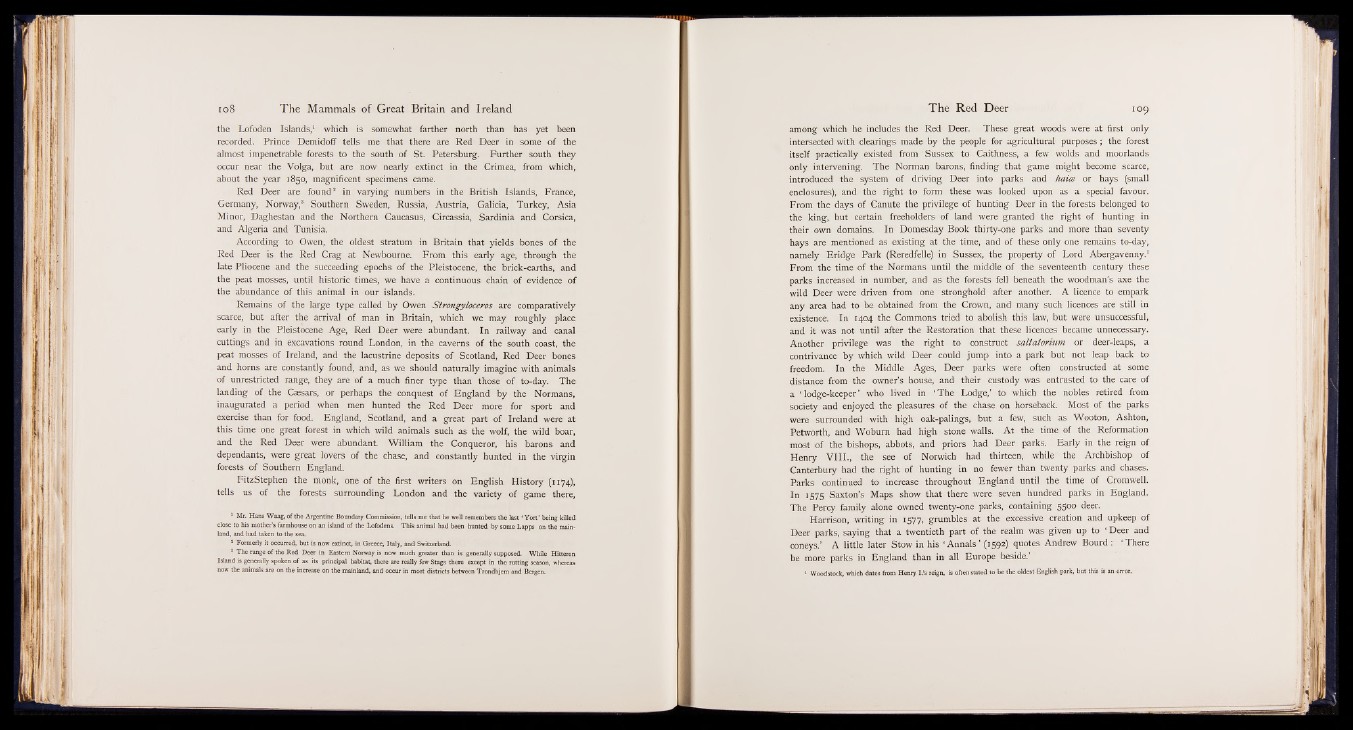
the Lofoden Islands,1 which is somewhat farther north than has yet been
recorded. Prince Demidoff tells me that there are Red Deer in some of the
almost impenetrable forests to the south of St. Petersburg. Further south they
occur near the Volga, but are now nearly extinct in the Crimea, from which,
about the year 1850, magnificent specimens came.
Red Deer are found2 in varying numbers in the British Islands, France,
Germany, Norway,8 Southern Sweden, Russia, Austria, Galicia, Turkey, Asia
Minor, Daghestan and the Northern Caucasus, Circassia, Sardinia and Corsica,
and Algeria and Tunisia.
According to Owen, the oldest stratum in Britain that yields bones of the
Red Deer is the Red Crag at Newbourne. From this early age, through the
late Pliocene and the succeeding epochs of the Pleistocene, the brick-earths, and
the peat mosses, until historic times, we have a continuous chain of evidence of
the abundance of this animal in our islands.
Remains of the large type called by Owen Strongyloceros are comparatively
scarce, but after the arrival of man in Britain, which we may roughly place
early in the Pleistocene Age, Red Deer were abundant. In railway and canal
cuttings and in excavations round London, in the caverns of the south coast, the
peat mosses of Ireland, and the lacustrine deposits of Scotland, Red Deer bones
and horns are constantly found, and, as we should naturally imagine with animals
of unrestricted range, they are of a much finer type than those of to-day. The
landing of the Caesars, or perhaps the conquest of England by the Normans,
inaugurated a period when men hunted the Red Deer more for sport and
exercise than for food. England, Scotland, and a great part of Ireland were at
this time one great forest in which wild animals such as the wolf, the wild boar,
and the Red Deer were abundant. William the Conqueror, his barons and
dependants, were great lovers of the chase, and constantly hunted in the virgin
forests of Southern England.
FitzStephen the monk, one of the first writers on English History (1174),
tells us of the forests surrounding London and the variety of game there,
1 Mr. Hans Waag, of the Argentine Boundary Commission, tells me that he well remembers the last ‘ Yort’ being killed
dose to his mother’s farmhouse on an island of the Lofodens. This animal had been hunted by some Lapps on the mainland,
and had taken to the sea.
* Formerly it occurred, but is now extinct, in Greece, Italy, and Switzerland.
* The range of the Red Deer in Eastern Norway is now much greater than is generally supposed. While Hitteren
Island is generally spoken of as its prindpal habitat, there are really few Stags there except in the rutting season, whereas
now the animals are on the increase on the mainland, and occur in most districts between Trondhjem and Bergen.
among which he includes the Red Deer. These great woods were at first only
intersected with clearings made by the people for agricultural purposes; the forest
itself practically existed from Sussex to Caithness, a few wolds and moorlands
only intervening. The Norman barons, finding that game might become scarce,
introduced the system of driving Deer into parks and hazes or hays (small
enclosures), and the right to form these was looked upon as a special favour.
From the days of Canute the privilege of hunting Deer in the forests belonged to
the king, but certain freeholders of land were granted the right of hunting in
their own domains. In Domesday Book thirty-one parks and more than seventy
hays are mentioned as existing at the time, and of these only one remains to-day,
namely Eridge Park (Reredfelle) in Sussex, the property of Lord Abergavenny.1
From the time of the Normans until the middle of the seventeenth century these
parks increased in number, and as the forests fell beneath the woodman’s axe the
wild Deer were driven from one stronghold after another. A licence to empark
any area had to be obtained from the Crown, and many such licences are still in
existence. In 1404 the Commons tried to abolish this law, but were unsuccessful,
and it was not until after the Restoration that these licences became unnecessary.
Another privilege was the right to construct sanatorium or deer-leaps, a
contrivance by which wild Deer could jump into a park but not leap back to
freedom. In the Middle Ages, Deer parks were often constructed at some
distance from the owner’s house, and their custody was entrusted to the care of
a ‘ lodge-keeper’ who lived in ‘ The Lodge,’ to which the nobles retired from
society and enjoyed the pleasures of the chase on horseback. Most of the parks
were surrounded with high oak-palings, but a few, such as Wooton, Ashton,
Petworth, and Woburn had high stone walls. At the time of the Reformation
most of the bishops, abbots, and priors had Deer parks. Early in the reign of
Henry VIII., the see of Norwich had thirteen, while the Archbishop of
Canterbury had the right of hunting in no fewer than twenty parks and chases.
Parks continued to increase throughout England until the time of Cromwell.
In 1575 Saxton’s Maps show that there were seven hundred parks in England.
The Percy family alone owned twenty-one parks, containing 5500 deer.
Harrison, writing in 1577, grumbles at the excessive creation and upkeep of
Deer parks, saying that a twentieth part of the realm was given up to ‘ Deer and
coneys.’ A little later Stow in his ‘ Annals’ (1592) quotes Andrew Bourd : ‘ There
be more parks in England than in all Europe beside.’
1 Woodstock, which dates from Henry I.’s reign, is often stated to be the oldest English park, but this is an error.